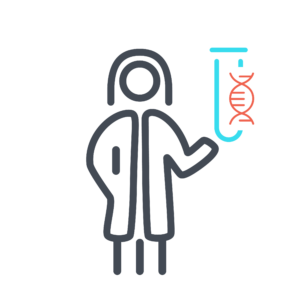16p13.3 Deletion Syndrome

Table of contents
- What is 16p13.3 deletion syndrome?
- Key Role
- Symptoms
- What causes 16p13.3 deletion syndrome?
- Why do I or my child have 16p13.3 deletion syndrome?
- What are the chances that other family members or future children will have 16p13.3 deletion syndrome?
- How many people have 16p13.3 deletion syndrome?
- Do people who have 16p13.3 deletion syndrome look different?
- How is 16p13.3 deletion syndrome treated?
- Behavior and development concerns linked to 16p13.3 deletion syndrome
- Medical and physical concerns linked to 16p13.3 deletion syndrome
- Where can I find support and resources?
- Sources and References
What is 16p13.3 deletion syndrome?
16p13.3 deletion syndrome happens when a person is missing a piece of chromosome 16, one of the body’s 46 chromosomes. Chromosomes are structures in our cells that house our genes. The missing piece can affect learning and how the body develops.
The size of the deletion affects the type of medical features. A small deletion results in Rubinstein-Taybi syndrome because the CREBBP gene is missing. A large deletion results in a different condition because additional genes are missing.

Key Role
Genes within the 16p13.3 region are important for brain development and function.
Symptoms
People with Rubinstein-Taybi syndrome may have:
- Developmental delay
- Intellectual disability
- Growth problems, such as short height or a smaller than average head size
- Hearing loss
- Upper airway infections
- Feeding difficulties
- Autism
- Seizures
- Speech delay
- Risk for tumor formation, especially in the head
- Risk for leukemia
People with a large deletion in the 16p13.3 region may have:
- Feeding difficulties
- Heart or kidney defects
- Frequent infections
- Developmental delay
- Intellectual disability
- Failure to thrive
- Low muscle tone
What causes 16p13.3 deletion syndrome?
16p13.3 deletion syndrome is a genetic condition, which means that it is caused by variants in genes. Our genes contain the instructions, or code, that tell our cells how to grow, develop, and work. Every child gets two copies of the 16p13.3 gene: one copy from their mother’s egg, and one copy from their father’s sperm. In most cases, parents pass on exact copies of the gene to their child. But the process of creating the egg or sperm is not perfect. A change in the genetic code can lead to physical issues, developmental issues, or both.
Sometimes a spontaneous variant happens in the sperm, egg or after fertilization. When a brand new genetic variant happens in the genetic code is called a ‘de novo’ genetic variant. The child is usually the first in the family to have the genetic variant.
De novo variants can take place in any gene. We all have some de novo variants, most of which don’t affect our health. But because 16p13.3 plays a key role in development, de novo variants in this gene can have a meaningful effect.
Research shows that 16p13.3 deletion syndrome is often the result of a de novo variant in 16p13.3. Many parents who have had their genes tested do not have the 16p13.3 genetic variant found in their child who has the syndrome. In some cases, 16p13.3 deletion syndrome happens because the genetic variant was passed down from a parent.
Autosomal dominant conditions
16p13.3 deletion syndrome is an autosomal dominant genetic condition. This means that when a person has the one damaging variant in 16p13.3 they will likely have symptoms of 16p13.3 deletion syndrome. For someone with an autosomal dominant genetic syndrome, every time they have a child there is a 50 percent chance they pass on the same genetic variant and a 50 percent chance they do not pass on the same genetic variant.
Autosomal Dominant Genetic Syndrome
Why do I or my child have 16p13.3 deletion syndrome?
No parent causes their child’s 16p13.3 deletion syndrome. We know this because no parent has any control over the chromosome changes that they do or do not pass on to their children. Please keep in mind that nothing a parent does before or during the pregnancy causes this to happen. The genetic change takes place on its own and cannot be predicted or stopped.
What are the chances that other family members or future children will have 16p13.3 deletion syndrome?
Each family is different. A geneticist or genetic counselor can give you advice on the chance that this will happen again in your family.
The risk of having another child who has 16p13.3 deletion syndrome depends on the genes of both biological parents.
- If neither biological parent has the same genetic variant found in their child, the chance of having another child who has the syndrome is on average 1 percent. This 1 percent chance is higher than the chance of the general population. The increase in risk is due to the very unlikely chance that more of the mother’s egg cells or the father’s sperm cells carry the same genetic variant.
- If one biological parent has the same genetic variant found in their child, the chance of having another child who has the syndrome is 50 percent.
For a symptom-free brother or sister of someone who has 16p13.3 deletion syndrome, the sibling’s risk of having a child who has 16p13.3 deletion syndrome depends on the sibling’s genes and their parents’ genes.
- If neither parent has the same genetic variant causing 16p13.3 deletion syndrome, the symptom-free sibling has a nearly 0 percent chance of having a child who would inherit 16p13.3 deletion syndrome.
- If one biological parent has the same genetic variant causing 16p13.3 deletion syndrome, the symptom-free sibling has a 50 percent chance of also having the same genetic variant. If the symptom-free sibling has the same genetic variant, their chance of having a child who has the genetic variant is 50 percent.
For a person who has 16p13.3 deletion syndrome, the risk of having a child who has the syndrome is about 50 percent.

How many people have 16p13.3 deletion syndrome?
Because of the different breakpoints that are possible in the 16p13.3 region, it is difficult to know how many people have 16p13.3 deletion syndrome.

Do people who have 16p13.3 deletion syndrome look different?
People with 16p13.3 deletion syndrome may look different. Appearance can vary and can include some but not all of these features:
- Short height
- A smaller than average head size, also called microcephaly
- Facial features that are different from those of other family members
- Wide thumbs that may have an unusual position on the hand
- Big first toes

How is 16p13.3 deletion syndrome treated?
Scientists and doctors have only just begun to study 16p13.3 deletion syndrome. At this point, there are no medicines designed to treat the syndrome. A genetic diagnosis can help people decide on the best way to track the condition and manage therapies. Doctors can refer people to specialists for:
- Physical exams and brain studies
- Genetics consults
- Development and behavior studies
- Other issues, as needed
A developmental pediatrician, neurologist, or psychologist can follow progress over time and can help:
- Suggest the right therapies. This can include physical, occupational, speech, or behavioral therapy.
- Guide individualized education plans (IEPs).
Specialists advise that therapies for 16p13.3 deletion syndrome should begin as early as possible, ideally before a child begins school.
If seizures happen, consult a neurologist. There are many types of seizures, and not all types are easy to spot. To learn more, you can refer to resources such as the Epilepsy Foundation’s website: epilepsy.com/…t-is-epilepsy/seizure-types

This section includes a summary of information from major published articles. It highlights how many people have different symptoms. To learn more about the articles, see the Sources and References section of this guide.
Behavior and development concerns linked to 16p13.3 deletion syndrome
The information below includes people with damaging variants in the CREBBP gene that cause Rubinstein-Taybi syndrome. Larger deletions or atypical deletions have not been consistently reported in medical research, and less is known about people with other 16p13.3 deletions.
Speech and Learning
Almost all people with Rubinstein-Taybi syndrome had developmental delay or intellectual disability (ID). People had moderate to severe ID. Infants spoke their first words around 2 years of age.
- 306 out of 309 people had developmental delay or intellectual disability (99 percent)
Behavior
About one-half of people with Rubinstein-Taybi syndrome had behavioral issues, such as autism, self-injury behavior, and aggressive behavior. People were often described as motivated to interact with others and ‘overly-friendly’.
- 151 out of 309 people had autism (49 percent)

Graphs
About one out of two people with Rubinstein-Taybi syndrome had autism.
Brain
Some people with Rubinstein-Taybi syndrome had seizures, and more than one-half of people had non-specific abnormalities on electroencephalogram (EEG). Over one-half had a smaller than average head size (microcephaly). Some people with Rubinstein-Taybi syndrome had brain changes seen on magnetic resonance imaging (MRI).
- 77 out of 309 people had seizures (25 percent)
- 167 out of 309 people had microcephaly (54 percent)
Medical and physical concerns linked to 16p13.3 deletion syndrome
Growth
Some people with Rubinstein-Taybi syndrome were born with heart defects. These included patent ductus arteriosus, persistent foramen ovale, and atrial and ventricular septal defect.
Babies often had delayed growth after birth, which appeared as a child dropping off the standard growth curve chart. In general, people did not have a growth spurt during puberty. Obesity was a problem for about 1 in 3 people.
- 108 out of 309 people had heart defects (35 percent)
- 232 out of 309 people had delayed growth after birth (75 percent)
- 90 out of 309 people had obesity (29 percent)

Gastrointestinal tract and urinary tract
It was common for people with Rubinstein-Taybi syndrome to have constipation into adulthood. Some people had urinary tract issues, such as horseshoe kidney, kidney duplication, kidney agenesis, kidney dysplasia, hydronephrosis, nephrolithiasis, and vesicoureteral reflux.
- 235 out of 309 people had constipation (76 percent)
- 86 out of 309 people had urinary tract defects (28 percent)

Where can I find support and resources?
Simons Searchlight
Simons Searchlight is an online international research program, building an ever growing natural history database, biorepository, and resource network of over 175 rare genetic neurodevelopmental disorders. By joining their community and sharing your experiences, you contribute to a growing database used by scientists worldwide to advance the understanding of your genetic condition. Through online surveys and optional blood sample collection, they gather valuable information to improve lives and drive scientific progress. Families like yours are the key to making meaningful progress. To register for Simons Searchlight, go to the Simons Searchlight website at www.simonssearchlight.org and click “Join Us.”
- Learn more about Simons Searchlight: www.simonssearchlight.org/frequently-asked-questions
- Simons Searchlight webpage with more information on 16p13.3 deletion: www.simonssearchlight.org/research/what-we-study/16p13-3-deletion
- Simons Searchlight Facebook group: https://www.facebook.com/groups/16p13.3deletion

Sources and References
The content in this guide comes from published studies about 15q13.3 deletion syndrome. Below you can find details about each study.
- Lacombe, D., Bloch-Zupan, A., Bredrup, C., Cooper, E. B., Houge, S. D., García-Miñaúr, S., Kayserili, H., Larizza, L., Lopez Gonzalez, V., … & Hennekam, R. C. (2024). Diagnosis and management in Rubinstein-Taybi syndrome: First international consensus statement. Journal of Medical Genetics, 61(6), 503-519. https://pmc.ncbi.nlm.nih.gov/articles/PMC11137475/
- Stevens, C. A. Rubinstein-Taybi syndrome. 2003 Nov 9. In: Adam MP, Feldman J, Mirzaa GM, et al., editors. GeneReviews® [Internet]. Seattle (WA): University of Washington, Seattle; 1993-2025. Available from: https://www.ncbi.nlm.nih.gov/books/NBK1526/
